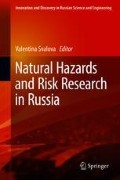Abstract
Analysis of seismological phone changes will give possibility to elaborate early-warning system. Sergeev Institute of Environmental Geoscience RAS (IEG RAS) has developed and delivered the “System monitoring acceleration induced on the upper part of the offshore oil and gas platforms” for deposits Lunskoye-A (LUN-A) and Piltun-Astokhskoye-B (PA-B) for Sakhalin-2 project. The system is intended to ensure the safety of the operation of these facilities.
Experience of the system creation was used for real-time early-warning landslide monitoring system construction. This system was successfully used for landslides monitoring of coastal slope of the river Yenisei.
Access this chapter
Tax calculation will be finalised at checkout
Purchases are for personal use only
References
Ginzburg, A. A., Manukin, A. B., Mironov, O. K., & Novikova, A. V. (2009). The spatial and spectral characteristics caused by earthquakes and other effects of fluctuations in offshore oil and gas platforms. Geoecology, N5, 80–89.
Ginzburg, A. A., Itzko, A. S., Kondratenko, A. I., Manukin, A. B., Mironov, O. K., & Novikova, A. V. (2008). Simulation of different impacts on offshore oil and gas platforms for the detection of dangerous earthquakes systems. Questions Engineering Seismology, N2, 35, 5–13.
Nikolaev, A. V., Bashilov, I. P., Shou, K.-J., Svalova, V. B. Manukin, A. B., Zubko, Y. N., Behterev, S. V., Kazantseva, O. S., & Rebrov, V. I. (2011). Some directions of works on maintenance of geological safety of engineering constructions. In Proceedings of ENGEOPRO, Moscow, p. 7.
Postoev, G. P., & Svalova, V. B. (2005). Landslides risk reduction and monitoring for urban territories in Russia. In Proceedings of the first general assembly of ICL (International Consortium on Landslides), “Landslides: risk analysis and sustainable disaster management” (pp 297–303), Washington, DC: Springer.
Svalova, V. B. (2009). Mechanical-mathematical modeling for sedimentary movement and landslide processes. In CD proceedings of the international association for mathematical geosciences meeting (IAMG 2009), Stanford, p. 15.
Svalova, V. B. (2011). Mechanical-mathematical modeling and monitoring for landslide processes. Journal of Environmental Science and Engineering, 5(10), 1282–1287.
Svalova, V. (2011). Monitoring and modeling of landslide processes. Monitoring Science and Technology, 2(7), 19–27 (in Russian).
Svalova, V. B. (2011). Landslide process simulation and monitoring. In Proceedings of ENGEOPRO, Moscow, p. 7.
Svalova, V. B. (2012). Mechanical-mathematical modeling and monitoring for landslides. In Proceedings of IPL (International Program on Landslides) symposium (pp. 63–68). Paris: UNESCO.
Svalova, V. B. (2013). Risk reduction for landslide hazards. Modeling and monitoring. In Proceedings of The International Conference Natural risks: analysis, estimation, mapping (pp. 157–163), Moscow: MSU. (In Russian).
Svalova, V. B. (2014). Modeling and monitoring for landslide processes. In K. Linwood (Ed.), Chapter in book: Natural disasters – typhoons and landslides – risk prediction, crisis management and environmental impacts (pp. 177–198). New York: Nova Science Publishers.
Svalova, V. B. (2014). Mechanical-mathematical modeling and monitoring for landslide processes. In IPL 163 Project. Proceedings of the world landslide forum 3 (Vol. 4, pp. 24–27). Beijing.
Svalova, V. B. (2014). Modeling and monitoring for landslide processes: Case study of Moscow and Taiwan. In Proceedings of the world landslide forum 3 (Vol. 4, pp. 628–632). Beijing.
Svalova, V. B. (2015). Mechanical modeling and geophysical monitoring for landslide processes. In Proceedings of IAEG XII congress “Engineering geology for society and territory” Torino-2014 (Vol. 2, pp. 345–348), Italy: Springer.
Svalova, V. (2017). Landslide risk: Assessment, management and reduction (p. 253). New York: Nova Science Publishers.
Svalova, V., & Postoev, G. (2008). Landslide process activization on sites of cultural heritage in Moscow, Russia. In Proceedings of the first world landslide forum 2008, Tokyo, p. 4.
Author information
Authors and Affiliations
Corresponding author
Editor information
Editors and Affiliations
Rights and permissions
Copyright information
© 2019 Springer International Publishing AG, part of Springer Nature
About this chapter
Cite this chapter
Ginzburg, A., Svalova, V., Nikolaev, A., Manukin, A., Savosin, V. (2019). Early-Warning Landslide Monitoring System. In: Svalova, V. (eds) Natural Hazards and Risk Research in Russia. Innovation and Discovery in Russian Science and Engineering. Springer, Cham. https://doi.org/10.1007/978-3-319-91833-4_5
Download citation
DOI: https://doi.org/10.1007/978-3-319-91833-4_5
Published:
Publisher Name: Springer, Cham
Print ISBN: 978-3-319-91832-7
Online ISBN: 978-3-319-91833-4
eBook Packages: Earth and Environmental ScienceEarth and Environmental Science (R0)

